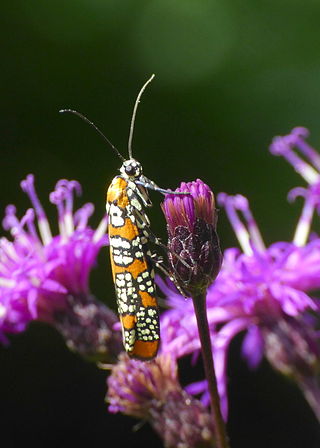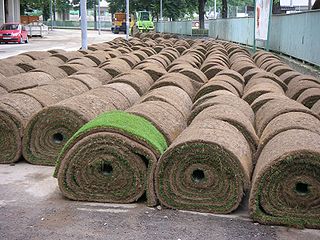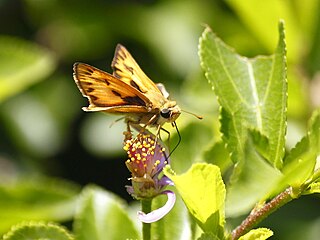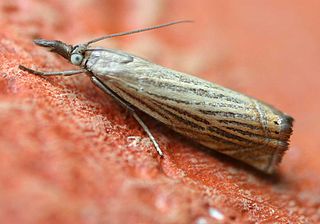
The ailanthus webworm is an ermine moth now found commonly in the United States. It was formerly known under the scientific name Atteva punctella. This small, very colorful moth resembles a true bug or beetle when not in flight, but in flight it resembles a wasp.

Crambidae comprises the grass moth family of lepidopterans. They are variable in appearance, with the nominal subfamily Crambinae taking up closely folded postures on grass stems where they are inconspicuous, while other subfamilies include brightly coloured and patterned insects that rest in wing-spread attitudes.

The Pyralidae, commonly called pyralid moths, snout moths or grass moths, are a family of Lepidoptera in the ditrysian superfamily Pyraloidea. In many classifications, the grass moths (Crambidae) are included in the Pyralidae as a subfamily, making the combined group one of the largest families in the Lepidoptera. The latest review by Eugene G. Munroe and Maria Alma Solis retain the Crambidae as a full family of Pyraloidea.

Sod is the upper layer of turf that is harvested for transplanting. Turf consists of a variable thickness of a soil medium that supports a community of turfgrasses.

Ailanthus altissimaay-LAN-thəss al-TIH-sim-ə, commonly known as tree of heaven, Ailanthus, varnish tree, copal tree, stinking sumac, Chinese sumac, paradise tree, or in Chinese as chouchun, is a deciduous tree in the family Simaroubaceae. It is native to northeast and central China, and Taiwan. Unlike other members of the genus Ailanthus, it is found in temperate climates rather than the tropics.

The Pyraloidea are a moth superfamily containing about 16,000 described species worldwide, and probably at least as many more remain to be described. They are generally fairly small moths, and as such, they have been traditionally associated with the paraphyletic Microlepidoptera.

The fall webworm is a moth in the family Erebidae known principally for its larval stage, which creates the characteristic webbed nests on the tree limbs of a wide variety of hardwoods in the late summer and fall. It is considered a pest but does not harm otherwise healthy trees. It is well known to commercial tree services and arboriculturists. Fall webworms are an invasive species in East Asia.

Bouteloua dactyloides, commonly known as buffalograss or buffalo grass, is a North American prairie grass native to Canada, Mexico, and the United States. It is a short grass found mainly on the High Plains and is co-dominant with blue grama over most of the shortgrass prairie. Buffalo grass in North America is not the same species of grass commonly known as "buffalo" in Australia.

The fiery skipper is a species of butterfly in the family Hesperiidae. Reaching approximately 1 inch (2.5 cm) in length, male fiery skippers are orange or yellow while the females are dark brown. Small brown spots may be observed on both the hindwing and forewing of both sexes although to a varying degree. Females may be darker brown overall with pale checkered markings on the hindwing. Fiery skipper larvae, or caterpillars, are greenish pink-grey with a black head and constricted neck. These larvae are often considered pests and can feed on Bermudagrass, creeping bentgrass, and St. Augustine grass.

The genus Crambus includes around 155 species of moths in the family Crambidae, distributed globally. The adult stages are called crambid snout moths, while the larvae of Crambus and the related genus Herpetogramma are the sod webworms, which can damage grasses.

Achyra rantalis, the garden webworm, is a moth of the family Crambidae described by Achille Guenée in 1854. It is found in North America, where it has been recorded from Maine to southern Quebec and Ontario, south to Florida and Mexico. It has also been recorded from Iowa, Colorado, California and the West Indies. Its habitat consists of fields and gardens.

Chrysoteuchia is a genus of moths of the family Crambidae described by Jacob Hübner in 1825. Most are native to Asia.

Hellula undalis, the cabbage webworm or Old World webworm, is a moth of the family Crambidae. It is a widespread species which is found from Europe across Asia to the Pacific. It was first described from Italy.

Herpetogramma licarsisalis, commonly known as the grass webworm or pale sod-webworm, is a species of moth in the family Crambidae.

Chrysoteuchia topiarius, the topiary grass-veneer moth, subterranean sod webworm or cranberry girdler, is a moth of the family Crambidae. The species was first described by Philipp Christoph Zeller in 1866. It is found in most of North America.

Hymenia perspectalis, the spotted beet webworm moth, is a species of moth of the family Crambidae. It is found in various parts of the world, including North America, where it is found from Maine to Florida, west to Texas and north to Michigan and Ontario. It is also found in Belize, Hong Kong, Jamaica, Australia (Queensland), the Comoros, Equatorial Guinea, Réunion and South Africa. The species was described by Jacob Hübner in 1796.

Herpetogramma aeglealis, commonly known as the serpentine webworm moth, is a species of moth in the family Crambidae. It was first described by Francis Walker in 1859 and is found in eastern North America.

Agriphila ruricolella, the lesser vagabond sod webworm, is a moth in the family Crambidae. It was described by Philipp Christoph Zeller in 1863. It is found in North America, where it has been recorded from Quebec and Maine to South Carolina, west to Arizona and north to Alberta. The habitat consists of grasslands, weedy areas, fields and cultivated areas.
Crambus tutillus is a moth in the family Crambidae. It was described by James Halliday McDunnough in 1921. It is found in North America, where it has been recorded from British Columbia and Oregon.




















